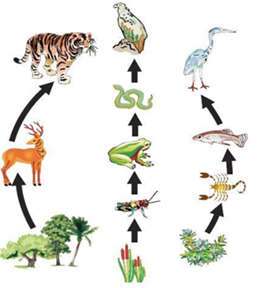NCERT Solutions for Class 7 Science Chapter 1 Nutrition in Plants
NCERT Solutions for CBSE Class 7 Science Chapter 1 Nutrition in Plants are given below. These solutions help students to clear their doubts and to obtain good marks in final exam. Class 7 Science NCERT questions and answers provided in this article are strictly based on the CBSE syllabus and curriculum.
Class 7 Science Chapter 1 Nutrition in Plants NCERT Solutions
Class 7 NCERT Solutions for Science Chapter 1 includes all the intext and exercise questions. All these questions are solved by experts with a detailed explanation that will help students complete their assignments and homework.
EXERCISES
Question 1: Why do organisms need to take food?
Answer: All organisms need to take food to get energy for the growth, development and maintenance of their bodies.
Question 2: Distinguish between a parasite and a saprotroph.
Answer: Difference between a parasite and a saprotroph:
| Parasite | Saprotroph |
| Organisms derive nutrition from the body of other living organisms (host) are parasites. | Plants which derive nutrition from dead and decaying organisms are called saprotrophs. |
| Example: Cuscata (Amarbel) | Example: Mushrooms. |
Question 3: How would you test the presence of starch in leaves?
Answer: Iodine solution is used to test leaves for the presence of starch.
In order to perform this test, one needs to heat the plant leaf in boiling water for 30 seconds to 1 minute and after that heat in boiling ethanol for a few minutes. Wash with water and spread onto a white tile and add a few drops of iodine solution. The parts of the leaf that contains starch will change its colour blue-black.
Question 4: Give a brief description of the process of synthesis of food in green plants.
Answer: Leaves are the food factories of plants. The synthesis of food in plants occurs in leaves. Therefore, all the raw materials (Water, Carbon dioxide and sunlight) must reach there. Water and minerals are transported to the leaves by the vessels which run like pipes throughout the root, the stem, the branches and the leaves. The leaves have a green pigment called chlorophyll which helps leaves to capture the energy of the sunlight. This energy is used to synthesis (prepare) food from carbon dioxide and water.

Question 5: Show with the help of a sketch that the plants are the ultimate source of food.
Answer: All the living being depends on plants whether directly or indirectly. For example, the plant eater animals depends directly on plants but carnivore depends indirectly on plants. The following sketch shows some examples of plant dependency.

Question 6: Fill in the blanks:
(a) Green plants are called _________________ since they synthesise their own food.
(b) The food synthesised by plants is stored as _________________.
(c) In photosynthesis solar energy is absorbed by the pigment called ___________.
(d) During photosynthesis plants take in ______________________ and release __________________ gas.
Answer: (a) Green plants are called autotrophs since they synthesise their food.
(b) The food synthesised by plants is stored as starch.
(c) In photosynthesis, solar energy is absorbed by the pigment called chlorophyll.
(d) During photosynthesis, plants take in Carbon dioxide and release Oxygen gas.
Question 7: Name the following:
(i) A parasitic plant with yellow, slender and tubular stem.
(ii) A plant that has both autotrophic and heterotrophic mode of nutrition.
(iii) The pores through which leaves exchange gases.
Answer:
(i) Cuscuta
(ii) Pitcher plant
(iii) Stomata
Question 8: Tick the correct answer:
(a) Amarbel is an example of:
(i) autotroph
(ii) parasite
(iii) saprotroph
(iv) host
Answer: (a) (ii) parasite.
(b) The plant which traps and feeds on insects is:
(i) Cuscuta
(ii) china rose
(iv) pitcher plant
(iv) rose
Answer: (b) (iv) pitcher plant.
Question 9: Match the items given in Column I with those in Column II:
| Column- I | Column-II |
| Chlorophyll | Rhizobium |
| Nitrogen | Heterotrophs |
| Cuscuta | Pitcher plant |
| Animals | Leaf |
| Insects | Parasite |
Answer:
| Column- I | Column-II |
| Chlorophyll | Leaf |
| Nitrogen | Rhizobium |
| Cuscuta | Parasite |
| Animals | Heterotrophs |
| Insects | Pitcher plant |
Question 10: Mark ‘T’ if the statement is true and ‘F’ if it is false:
(i) Carbon dioxide is released during photosynthesis. (T/F)
(ii) Plants which synthesise their food themselves are called saprotrophs. (T/F)
(iii) The product of photosynthesis is not a protein. (T/F)
(iv) Solar energy is converted into chemical energy during photosynthesis. (T/F)
Answer: (i) Carbon dioxide is released during photosynthesis. (False)
(ii) Plants which synthesise their food themselves are called saprotrophs. (False)
(iii) The product of photosynthesis is not a protein. (True)
(iv) Solar energy is converted into chemical energy during photosynthesis. (True)
Question 11: Choose the correct option from the following:
Which part of the plant takes in carbon dioxide from the air for photosynthesis?
(i) Root hair
(ii) Stomata
(iii) Leaf veins
(iv) Sepals
Answer: (ii) Stomata
Question 12: Choose the correct option from the following:
Plants take carbon dioxide from the atmosphere mainly through their:
(i) roots
(ii) stem
(iii) flowers
(iv) leaves
Answer: (iv) leaves